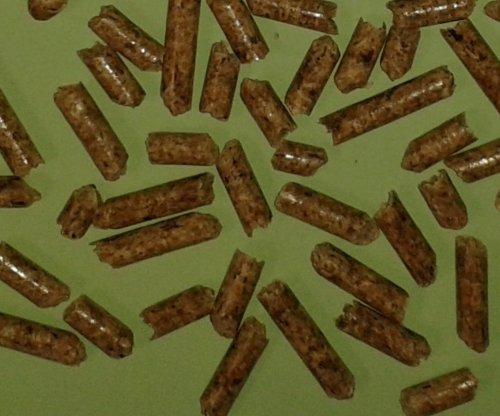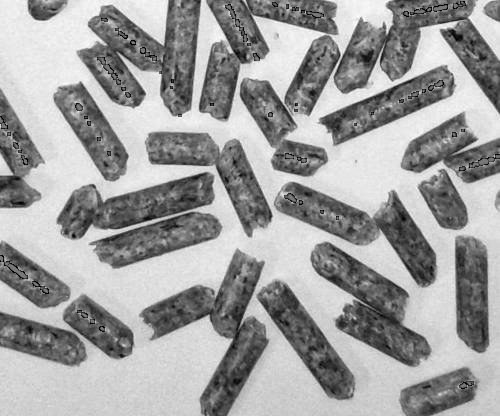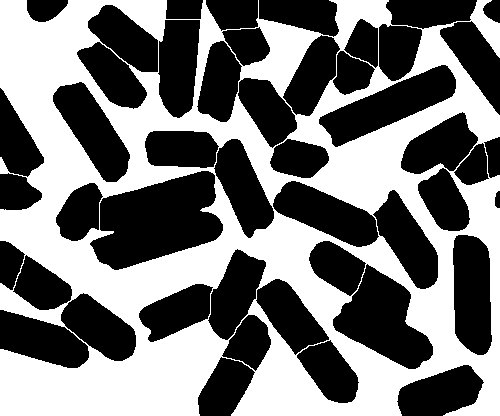Segmenting touching tubular objects
Segmenting touching tubular objects
|
Dear ImageJists,
I'd like to use ImageJ in an picture analysis for a in theory simple topic which appears not so easy for me in practise. I have photographs of small zylindric pellets and want to analyse them with the Particle analyzer. Beside the issue that the picture carries some reflections which I have more or less managed to get rid of. But the major issue appears to be the segmentation: the objects to analyse are not separated and are partly touching each other while having a elongated and cylindric form. The Watershed algorithm is not strong on such geometries and I have not been able to find the right filters to reliably separate the different objects. Are there tools available for such geometries or is it even easier by just applying the right filters?    Thanks in advance for your effort. ecophysulm
Essen, Germany
|
Re: Segmenting touching tubular objects
|
On Friday 29 Jan 2016 16:47:26 ecophysulm wrote:
> I'd like to use ImageJ in an picture analysis for a in theory simple topic > which appears not so easy for me in practise. > I have photographs of small zylindric pellets and want to analyse them with > the Particle analyzer. Beside the issue that the picture carries some > reflections which I have more or less managed to get rid of. But the major > issue appears to be the segmentation: the objects to analyse are not > separated and are partly touching each other while having a elongated and > cylindric form. It will be difficult to separate 2 pellets side by side with the watershed separation. It is not made for that kind of problem. I see this as a problem that could be resolved outside the imaging part. What you want is to have the objects completely separated from each other from the start, so you do not have to separate them. I would use some kind of surface or tray where the pellets fall/slot in a preferred position and cannot overlap. I am thinking of some surface with grooves or undulations? Cheers Gabriel -- ImageJ mailing list: http://imagej.nih.gov/ij/list.html |
Re: Segmenting touching tubular objects
|
I agree. Cut grooves in a small wooden plate in regular intervals and get
your pellets to sit in them. Take a photo and then your life is much easier. Something like this site offers should be available where you are. Or ask around about a hacker/makerspace locally. They would likely cut something for you for a fee. Paint it a reasonable "background" color and shake your product over it to get things into the grooves. We've done this for similar shaped objects at my work. B On Sat, Jan 30, 2016 at 2:20 AM, Gabriel Landini <[hidden email]> wrote: > On Friday 29 Jan 2016 16:47:26 ecophysulm wrote: > > I'd like to use ImageJ in an picture analysis for a in theory simple > topic > > which appears not so easy for me in practise. > > I have photographs of small zylindric pellets and want to analyse them > with > > the Particle analyzer. Beside the issue that the picture carries some > > reflections which I have more or less managed to get rid of. But the > major > > issue appears to be the segmentation: the objects to analyse are not > > separated and are partly touching each other while having a elongated and > > cylindric form. > > It will be difficult to separate 2 pellets side by side with the watershed > separation. It is not made for that kind of problem. > > I see this as a problem that could be resolved outside the imaging part. > What you want is to have the objects completely separated from each other > from > the start, so you do not have to separate them. > > I would use some kind of surface or tray where the pellets fall/slot in a > preferred position and cannot overlap. > I am thinking of some surface with grooves or undulations? > > Cheers > Gabriel > > -- > ImageJ mailing list: http://imagej.nih.gov/ij/list.html > -- ImageJ mailing list: http://imagej.nih.gov/ij/list.html |
Re: Segmenting touching tubular objects
|
Forgot to paste the site:
http://www.ponoko.com/laser-cutting On Sat, Jan 30, 2016 at 8:03 AM, Brandon Hurr <[hidden email]> wrote: > I agree. Cut grooves in a small wooden plate in regular intervals and get > your pellets to sit in them. Take a photo and then your life is much > easier. > > Something like this site offers should be available where you are. Or ask > around about a hacker/makerspace locally. They would likely cut something > for you for a fee. Paint it a reasonable "background" color and shake your > product over it to get things into the grooves. We've done this for similar > shaped objects at my work. > > B > > On Sat, Jan 30, 2016 at 2:20 AM, Gabriel Landini <[hidden email]> > wrote: > >> On Friday 29 Jan 2016 16:47:26 ecophysulm wrote: >> > I'd like to use ImageJ in an picture analysis for a in theory simple >> topic >> > which appears not so easy for me in practise. >> > I have photographs of small zylindric pellets and want to analyse them >> with >> > the Particle analyzer. Beside the issue that the picture carries some >> > reflections which I have more or less managed to get rid of. But the >> major >> > issue appears to be the segmentation: the objects to analyse are not >> > separated and are partly touching each other while having a elongated >> and >> > cylindric form. >> >> It will be difficult to separate 2 pellets side by side with the watershed >> separation. It is not made for that kind of problem. >> >> I see this as a problem that could be resolved outside the imaging part. >> What you want is to have the objects completely separated from each other >> from >> the start, so you do not have to separate them. >> >> I would use some kind of surface or tray where the pellets fall/slot in a >> preferred position and cannot overlap. >> I am thinking of some surface with grooves or undulations? >> >> Cheers >> Gabriel >> >> -- >> ImageJ mailing list: http://imagej.nih.gov/ij/list.html >> > > -- ImageJ mailing list: http://imagej.nih.gov/ij/list.html |
Re: Segmenting touching tubular objects
|
This is the kind of problem that separates “Image Processing” from “Computer Vision”.
While I completely agree that IF YOU HAVE CONTROL over the image acquisition, it is most efficient to design the imaging situation so that Image Processing will suffice - it’s also true that humans would have little trouble outlining the ellipses in the supplied images. If humans can do it, they so can computers - it just takes more work. I have spent 40 years with this situation : the customer arrives with a job that *can* be done - but it will take a year of development work. OR, I can give advice on how to make the problem simple enough that I can do my part in 15 minutes. Usually, I do both - the customer fixes the imaging situation so that the image processing is simple, and results start flowing within a week. In the meantime, I give the realHardProblem to my students, who typically take 2 years to solve it….by which time the customer is no longer interested and has moved on to an even harder problem. Apply, Rinse. Repeat. Here’s an approach I might take (but please don’t take this as a serious suggestion as to what YOU should do). First, look for robust edges. Think of these as “obstacles”. Next, find seed points in the middle of large expanses of “lighter” regions (perhaps use the edges to suggest places to place the seed and what the value of “lighter” is locally. Next, construct circular polygons that lie completely INSIDE the “lighter” region. Now…try to “blow up the balloons” by moving the vertices of the polygons away from the polygon centroid, while enforcing two conditions: a) the polygon must remain free of “Obstacles”, and b) apply a smoothness constraint on the curvature of the polygon at every vertex. This will give you an smooth, compact blob, touching obstacles on many (but not all) sides. Reject tiny blobs. Reject large blobs and try to develop methods of breaking up large blobs into two or more correctly sized blobs. Think about how a human would approach this, given a print and a pencil. Do it that way. Now, I will grant that there is probably not a FIJI plugin to do this. It can’t be done overnight. But, it can be done. No - I’m not offering to do it. The point is that you have knowledge about the scene that is *not* about pixel level classifications. You can *almost* get there with watershed-like ideas (perhaps someone will succeed at that). But, there comes a time when you have to move up a level of abstraction and think about the scene, and not the image. You could do something very similar with a Region Growing approach, with a constraint on the complexity of the boundary of the region. — Kenneth Sloan [hidden email] <mailto:[hidden email]> Vision is the art of seeing what is invisible to others. > On Jan 30, 2016, at 10:09, Brandon Hurr <[hidden email]> wrote: > > Forgot to paste the site: > http://www.ponoko.com/laser-cutting > > > > On Sat, Jan 30, 2016 at 8:03 AM, Brandon Hurr <[hidden email]> > wrote: > >> I agree. Cut grooves in a small wooden plate in regular intervals and get >> your pellets to sit in them. Take a photo and then your life is much >> easier. >> >> Something like this site offers should be available where you are. Or ask >> around about a hacker/makerspace locally. They would likely cut something >> for you for a fee. Paint it a reasonable "background" color and shake your >> product over it to get things into the grooves. We've done this for similar >> shaped objects at my work. >> >> B >> >> On Sat, Jan 30, 2016 at 2:20 AM, Gabriel Landini <[hidden email]> >> wrote: >> >>> On Friday 29 Jan 2016 16:47:26 ecophysulm wrote: >>>> I'd like to use ImageJ in an picture analysis for a in theory simple >>> topic >>>> which appears not so easy for me in practise. >>>> I have photographs of small zylindric pellets and want to analyse them >>> with >>>> the Particle analyzer. Beside the issue that the picture carries some >>>> reflections which I have more or less managed to get rid of. But the >>> major >>>> issue appears to be the segmentation: the objects to analyse are not >>>> separated and are partly touching each other while having a elongated >>> and >>>> cylindric form. >>> >>> It will be difficult to separate 2 pellets side by side with the watershed >>> separation. It is not made for that kind of problem. >>> >>> I see this as a problem that could be resolved outside the imaging part. >>> What you want is to have the objects completely separated from each other >>> from >>> the start, so you do not have to separate them. >>> >>> I would use some kind of surface or tray where the pellets fall/slot in a >>> preferred position and cannot overlap. >>> I am thinking of some surface with grooves or undulations? >>> >>> Cheers >>> Gabriel >>> >>> -- >>> ImageJ mailing list: http://imagej.nih.gov/ij/list.html >>> >> >> > > -- > ImageJ mailing list: http://imagej.nih.gov/ij/list.html -- ImageJ mailing list: http://imagej.nih.gov/ij/list.html |
Re: Segmenting touching tubular objects
|
In reply to this post by ecophysulm
Your problem indeed reminds me more of edge detection.
I managed segmenting some touching objects by applying anisotropic diffusion algorithm as a preprocessing step. Can you show examples? Dimiter Prodanov -- ImageJ mailing list: http://imagej.nih.gov/ij/list.html |
«
Return to ImageJ
|
1 view|%1 views
| Free forum by Nabble | Edit this page |

